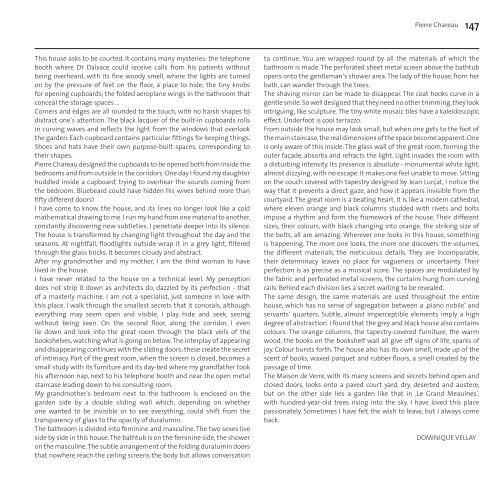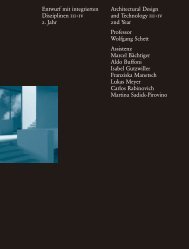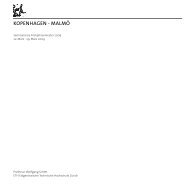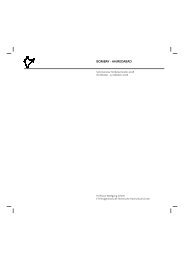Layout LC.indd - Professur Schett
Layout LC.indd - Professur Schett
Layout LC.indd - Professur Schett
Erfolgreiche ePaper selbst erstellen
Machen Sie aus Ihren PDF Publikationen ein blätterbares Flipbook mit unserer einzigartigen Google optimierten e-Paper Software.
This house asks to be courted. It contains many mysteries: the telephone<br />
booth where Dr Dalsace could receive calls from his patients without<br />
being overheard, with its fi ne woody smell, where the lights are turned<br />
on by the pressure of feet on the fl oor, a place to hide; the tiny knobs<br />
for opening cupboards; the folded aeroplane wings in the bathroom that<br />
conceal the storage spaces ...<br />
Corners and edges are all rounded to the touch, with no harsh shapes to<br />
distract one‘s attention. The black lacquer of the built-in cupboards rolls<br />
in curving waves and refl ects the light from the windows that overlook<br />
the garden. Each cupboard contains particular fi ttings for keeping things.<br />
Shoes and hats have their own purpose-built spaces, corresponding to<br />
their shapes.<br />
Pierre Chareau designed the cupboards to be opened both from inside the<br />
bedrooms and from outside in the corridors. One day I found my daughter<br />
huddled inside a cupboard, trying to overhear the sounds coming from<br />
the bedroom. Bluebeard could have hidden his wives behind more than<br />
fi fty different doors!<br />
I have come to know the house, and its lines no longer look like a cold<br />
mathematical drawing to me. I run my hand from one material to another,<br />
constantly discovering new subtleties. I penetrate deeper into its silence.<br />
The house is transformed by changing light throughout the day and the<br />
seasons. At nightfall, fl oodlights outside wrap it in a grey light, fi ltered<br />
through the glass bricks. It becomes cl0udy and abstract.<br />
After my grandmother and my mother, I am the third woman to have<br />
lived in the house.<br />
I have never related to the house on a technical level. My perception<br />
does not strip it down as architects do, dazzled by its perfection - that<br />
of a masterly machine. I am not a specialist, just someone in love with<br />
this place. I walk through the smallest secrets that it conceals, although<br />
everything may seem open and visible. I play hide and seek, seeing<br />
without being seen. On the second fl oor, along the corridor, I even<br />
lie down and look into the great room through the black veils of the<br />
bookshelves, watching what is going on below. The interplay of appearing<br />
and disappearing continues with the sliding doors; these create the secret<br />
of intimacy. Part of the great room, when the screen is closed, becomes a<br />
small study with its furniture and its day-bed where my grandfather took<br />
his afternoon nap, next to his telephone booth and near the open metal<br />
staircase leading down to his consulting room.<br />
My grandmother‘s bedroom next to the bathroom is enclosed on the<br />
garden side by a double sliding wall which, depending on whether<br />
one wanted to be invisible or to see everything, could shift from the<br />
transparency of glass to the opacity of duralumin.<br />
The bathroom is divided into feminine and masculine. The two sexes live<br />
side by side in this house. The bathtub is on the feminine side, the shower<br />
on the masculine. The subtle arrangement of the folding duralumin doors<br />
that nowhere reach the ceiling screens the body but allows conversation<br />
Pierre Chareau<br />
147<br />
to continue. You are wrapped round by all the materials of which the<br />
bathroom is made. The perforated sheet metal screen above the bathtub<br />
opens onto the gentleman‘s shower area. The lady of the house, from her<br />
bath, can wander through the trees.<br />
The shaving mirror can be made to disappear. The coat hooks curve in a<br />
gentle smile. So well designed that they need no other trimming, they look<br />
intriguing, like sculpture. The tiny white mosaic tiles have a kaleidoscopic<br />
effect. Underfoot is cool terrazzo.<br />
From outside the house may look small, but when one gets to the foot of<br />
the main staircase, the real dimensions of the space become apparent. One<br />
is only aware of this inside. The glass wall of the great room, forming the<br />
outer façade, absorbs and refracts the light. Light invades the room with<br />
a disturbing intensity. Its presence is absolute - monumental white light,<br />
almost dizzying, with no escape. It makes one feel unable to move. Sitting<br />
on the couch covered with tapestry designed by Jean Lurçat, I notice the<br />
way that it prevents a direct gaze, and how it appears invisible from the<br />
courtyard. The great room is a beating heart. It is like a modern cathedral,<br />
where eleven orange and black columns studded with rivets and bolts<br />
impose a rhythm and form the framework of the house. Their different<br />
sizes, their colours, with black changing into orange, the striking size of<br />
the bolts, all are amazing. Wherever one looks in this house, something<br />
is happening. The more one looks, the more one discovers the volumes,<br />
the different materials, the meticulous details. They are incomparable,<br />
their determinacy leaves no place for vagueness or uncertainty. Their<br />
perfection is as precise as a musical score. The spaces are modulated by<br />
the fabric and perforated metal screens, the curtains hung from curving<br />
rails. Behind each division lies a secret waiting to be revealed.<br />
The same design, the same materials are used throughout the entire<br />
house, which has no sense of segregation between a ‚piano nobile‘ and<br />
servants‘ quarters. Subtle, almost imperceptible elements imply a high<br />
degree of abstraction. I found that the grey and black house also contains<br />
colours. The orange columns, the tapestry-covered furniture, the warm<br />
wood, the books on the bookshelf wall all give off signs of life, sparks of<br />
joy. Colour bursts forth. The house also has its own smell, made up of the<br />
scent of books, waxed parquet and rubber fl oors, a smell created by the<br />
passage of time.<br />
The Maison de Verre, with its many screens and secrets behind open and<br />
cl0sed doors, looks onto a paved court yard, dry, deserted and austere,<br />
but on the other side lies a garden like that in ‚Le Grand Meaulnes‘,<br />
with hundred-year-old trees rising into the sky. I have loved this place<br />
passionately. Sometimes I have felt the wish to leave, but I always come<br />
back.<br />
DOMINIQUE VELLAY






